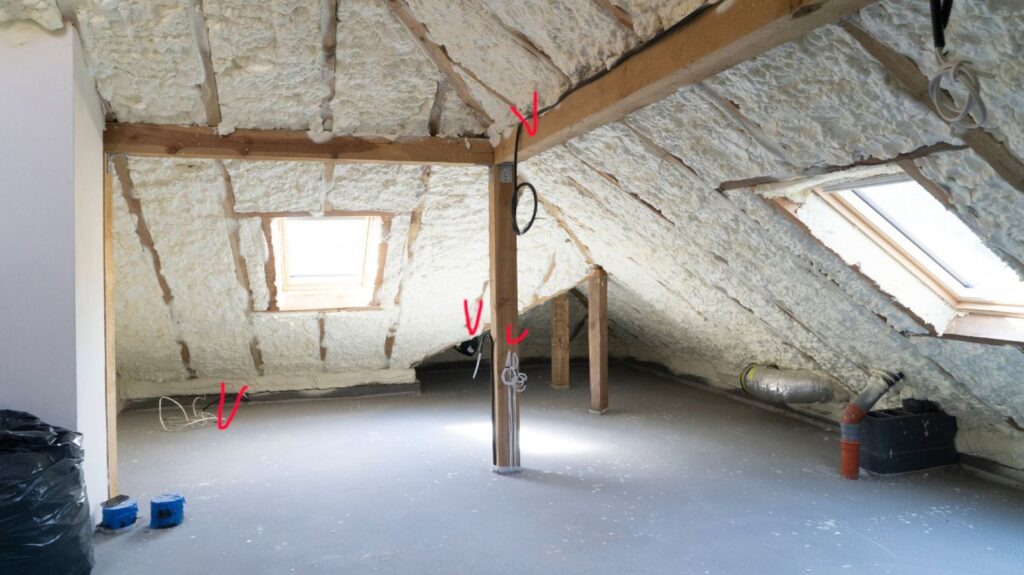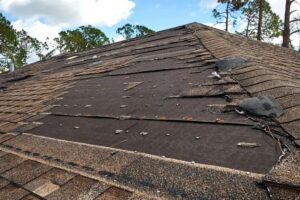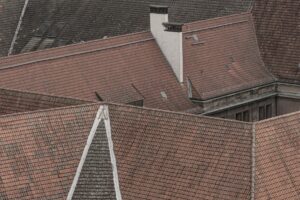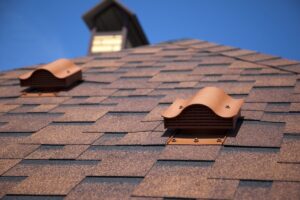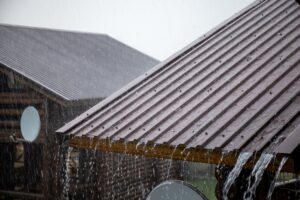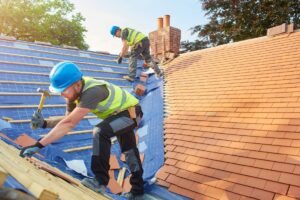Understanding the Role of Attic Insulation
Welcome to the world where comfort meets efficiency! Here, we’re going to unravel how the right attic insulation and roofing can drastically improve your home’s energy consumption, making those hot summers and cold winters a breeze to deal with, all while keeping your bills in check.
Attic insulation acts like a snug blanket for your home. It traps heat during winter and keeps your living spaces cool during summer, reducing the need for constant heating or air conditioning.
What’s the R-value in Attic Insulation?
The R-value in attic insulation refers to the material’s thermal resistance, or its ability to resist heat flow. Higher R-values indicate greater insulation effectiveness. The R-value needed for attic insulation varies depending on the climate zone and the specific energy requirements of the building. In colder regions, a higher R-value is necessary to prevent heat loss during the winter, while in warmer climates, the focus may be more on preventing heat gain during the summer.
5 Types of attic insulation
Choosing the right type of attic insulation is crucial for maintaining an energy-efficient home. The insulation in your attic plays a pivotal role in regulating your home’s temperature, keeping it warm in the winter and cool in the summer. Various insulation materials are available, each with unique properties, advantages, and considerations.
Below, we explore some of the most common types of attic insulation, helping you determine which might be the best fit for your home.
1. Fiberglass Batts
Fiberglass batts are perhaps the most recognized form of insulation. These come in large, flexible rolls that can be easily laid out between attic joists or wall studs.
- Pros: They are relatively inexpensive and easy to install, making them a popular choice for DIY projects. Fiberglass is also non-flammable, adding an extra layer of safety to your home.
- Cons: While effective, it can be irritating to the skin and lungs during installation, requiring protective gear. Additionally, if not properly installed with an air barrier, it can allow air movement, reducing its effectiveness.
2. Cellulose
Cellulose insulation is made from recycled paper products, primarily newsprint, treated with fire retardants. It’s either blown into the attic as loose fill or applied as a dense pack in enclosed cavities.
- Pros: It has a higher R-value per inch than fiberglass, offering better thermal and sound insulation. Being made from recycled materials, it’s also an eco-friendly choice.
- Cons: It can be more expensive than fiberglass and may require professional attic installation. If it gets wet, it can take a long time to dry out, potentially leading to mold issues.
3. Mineral Wool
Mineral wool can refer to either rock wool or slag wool and is made from molten rock or industrial waste spun into fibers.
- Pros: It offers excellent fire resistance and sound-dampening properties. It’s also resistant to mold and pests and doesn’t require additional fire-retardant treatments.
- Cons: Like cellulose, it can be more expensive than fiberglass and may require professional installation. The fibers can also be irritating to the skin and lungs, necessitating protective gear during installation.
4. Spray Foam
Spray foam insulation is applied wet and expands into a thick foam, filling spaces and sealing gaps. It comes in two types: open-cell and closed-cell.
- Pros: It provides an excellent air barrier, which can significantly reduce energy costs. The closed-cell foam also acts as a vapor barrier, adding moisture protection.
- Cons: It’s the most expensive option and must be installed by professionals. Improper installation can lead to uneven insulation and potential structural issues.
5. Reflective Insulation
Reflective insulation, or radiant barriers, are made from materials that reflect heat rather than absorb it, such as aluminum foils laminated to paper or plastic.
- Pros: It’s particularly effective in hot climates by reducing cooling costs. It’s lightweight, easy to install, and doesn’t degrade over time.
- Cons: Its effectiveness is limited in cooler climates, and it must be installed in a way that leaves a gap between the insulation and the roof decking to work effectively.
The Synergy Between Attic Insulation and Roofing
Your roof and attic insulation work together as a team. A well-insulated attic supports your roofing system by preventing ice dam formation in winter and reducing heat gain in summer.
The relationship between your attic insulation and roofing system is a prime example of how different components of your home can work in concert to achieve greater energy efficiency and comfort. This synergy is not just beneficial; it’s essential for maintaining the optimal performance of your home’s thermal envelope, which acts as a barrier between the indoor and outdoor environments.
Let’s delve deeper into how this dynamic duo operates throughout the seasons, ensuring your home remains a haven of comfort while also keeping those energy bills in check.
Winter Wonders: Battling Ice Dams and Heat Loss
In the colder months, the primary concern is preventing heat from escaping your living spaces. Warm air rising from your home can easily escape through an under-insulated attic, leading to significant heat loss. Moreover, this escaping heat can warm the underside of your roof, causing snow to melt and refreeze at the eaves, forming ice dams. These ice dams can cause water to back up under the shingles, leading to potential leaks and water damage.
A well-insulated attic acts as a barrier to this heat transfer. Maintaining a uniform temperature across the roof, it prevents the melt-freeze cycle that leads to ice dam formation. This not only protects the structural integrity of your roof but also helps in maintaining consistent indoor temperatures, reducing the workload on your heating system and, consequently, your energy expenditure.
Summer Shield: Reducing Heat Gain
During the warmer months, the challenge shifts to keeping excessive heat out of your home. The sun beating down on your roof can significantly increase attic temperatures, leading to heat gain within your living spaces. This can make your home uncomfortably warm and force your air conditioning system to work overtime, leading to higher energy bills.
Proper attic insulation acts as a thermal barrier, reducing heat transfer from the attic to your living spaces. By keeping your attic and, by extension, your home cooler, insulation helps in maintaining comfortable indoor temperatures with less reliance on air conditioning. This not only leads to energy savings but also prolongs the life of your cooling system by reducing its operational strain.
The Role of Ventilation
It’s important to note that insulation’s effectiveness is greatly enhanced by proper attic ventilation. Ventilation helps in regulating attic temperatures, preventing the buildup of excessive heat in summer and reducing moisture accumulation in winter. This moisture can compromise the effectiveness of insulation and lead to mold growth and rot, further threatening your roof’s integrity and your home’s air quality.
Signs You Need to Upgrade Your Attic Insulation
Attic insulation plays a crucial role in maintaining your home’s comfort and energy efficiency. Over time, however, insulation can deteriorate or become less effective due to various factors, including age, moisture, and pest infestation. Recognizing the signs that your attic insulation needs an upgrade is key to preventing discomfort, structural damage, and excessive energy consumption. Here are expanded details on some primary indicators that suggest your attic insulation requires attention, alongside additional signs to watch out for.
Ice Dams and Icicles
One of the most visible signs of inadequate attic insulation during the winter months is the formation of ice dams and the presence of icicles hanging from the eaves of your roof. Ice dams occur when heat escapes from a poorly insulated attic, melting the snow on the roof. This melted snow then refreezes at the roof’s edge, forming a dam that prevents proper drainage. The weight and pressure of the ice can damage your roof, while the icicles themselves can pose a risk to safety. Both are indicators that heat is not being retained effectively within your living spaces, pointing to underperforming attic insulation.
Skyrocketing Energy Bills
A sudden or gradual increase in your energy bills, especially during the peak heating or cooling seasons, is a strong indicator that your home is losing energy. If your heating or cooling system seems to be working overtime to maintain comfortable temperatures indoors, it’s likely that your attic insulation is not doing its job effectively. Insulation that is compacted, has settled over time or is simply insufficient for your climate can lead to significant energy loss through the attic.
Temperature Fluctuations
If you notice significant temperature variations between different rooms or floors in your home, it might be due to inadequate or unevenly distributed attic insulation. Proper insulation should help maintain consistent temperatures throughout your home. Rooms that feel particularly drafty or are difficult to keep warm in the winter or cool in the summer are often directly affected by poor attic insulation.
Wet or Damp Insulation
Insulation material that is wet or damp has likely been compromised. Water can drastically reduce the effectiveness of insulation by collapsing the air pockets that help to trap heat. Common sources of moisture include roof leaks, inadequate ventilation, and condensation. If you find that your attic insulation is wet or even slightly damp, it’s crucial to address not only the insulation replacement but also the source of the moisture.
Age of Insulation
Insulation doesn’t last forever. Most types have a lifespan after which they start to degrade, losing their effectiveness. If your home is older and hasn’t had an insulation update in decades, it’s likely time for an assessment and potential upgrade. Modern insulation materials offer improved energy efficiency and may be a wise investment for aging homes.
Addressing these signs promptly by upgrading your attic insulation can lead to immediate improvements in comfort, a reduction in energy bills, and the prevention of potential damage to your home. Consulting with a professional can help you determine the best insulation materials and methods to suit your needs and ensure your home remains comfortable and energy-efficient year-round.
Finding a Trusted Contractor for Proper Attic Insulation Installation
When it comes to ensuring your home in Aledo, TX, and the surrounding areas of Parker County, Tarrant County, and Johnson County is well-protected and energy-efficient, the integrity of your attic insulation and roofing cannot be overlooked. Greenlight Roofing and Remodeling, your Trusted Local Roofing Company with over 30 years of combined experience, we pride ourselves on being energy efficiency experts dedicated to providing top-notch roofing services. Catering to both residential and commercial clients, we understand the critical role that proper attic insulation plays in maintaining your home’s comfort and reducing energy costs.
Finding a trusted contractor for your attic insulation and roofing needs is paramount, and we’re here to guide you through the process.
- Research and Referrals: Start by researching local contractors with experience in attic insulation and roofing. Online reviews, testimonials, and referrals from friends or family can provide insight into a contractor’s reliability and quality of work.
- Check Credentials: Ensure the contractor is licensed, insured, and bonded. This protects you in case of accidents or damage during the project. Membership in professional organizations or certifications from insulation manufacturers can also indicate a higher level of expertise and commitment to quality.
- Experience and Specialization: Look for contractors who specialize in attic insulation and roofing. They will be more familiar with the latest materials, techniques, and energy efficiency standards.
- Consultation and Assessment: A reputable contractor should offer a thorough assessment of your attic and roofing needs. They should be willing to inspect your home, discuss your energy efficiency goals, and provide a detailed proposal with recommendations and cost estimates.
- Get Multiple Quotes: Obtain quotes from several contractors to compare prices, but remember that the cheapest option may not always provide the best value. Consider the materials used, the scope of work, and the contractor’s expertise.
Greenlight Roofing and Remodeling is committed to ensuring that every aspect of your roofing and attic insulation is handled with the utmost professionalism and expertise. Our team is equipped to assess, advise, and take action on your specific needs, guaranteeing results that not only meet but exceed your expectations. With us, your home’s roofing and insulation are in skilled hands, ready to enhance your living space’s comfort and energy efficiency for years to come.
Attic Maintenance Tips for Aledo, TX Homeowners
Maintaining your attic insulation and roofing is essential for their longevity and effectiveness. Here are tips from Greenlight Roofing and Remodeling to keep these critical areas in pristine condition year-round:
Spring and Summer:
Inspect your attic and roof for any signs of damage or leaks that may have occurred during the winter months. Look for water stains, mold, or damp insulation, and address these issues promptly. Ensure your attic is well-ventilated to prevent heat buildup, which can affect your home’s cooling efficiency.
Fall:
Clear debris, such as leaves and branches, from your roof and gutters to prevent water accumulation and ice dams in the winter. This is also a good time to check for and seal any air leaks in your attic. Ensuring your attic floor is properly insulated can prevent heat from escaping your living spaces.
Winter:
Monitor your attic and roof after heavy snowfall or ice storms. Ice dams can form if the attic is too warm, causing meltwater to refreeze at the roof’s edge. Consider installing an ice and water shield and proper ventilation to minimize this risk.
Year-Round:
Regularly check for any signs of pest infestation in your attic. Rodents and insects can damage insulation and wiring. Ensure there are no entry points for pests, and consider professional pest control if necessary.
By carefully selecting a trusted contractor for your attic insulation and roofing projects and adhering to a routine maintenance schedule, you can enhance your home’s energy efficiency, comfort, and safety. A well-insulated attic and a well-maintained roof not only contribute to immediate energy savings but also protect the long-term integrity and value of your home.
#1 Attic Insulation and Roofing Contractor in Aledo TX
Upgrading your attic insulation and roofing is an investment in your home’s future. Not only does it pay off in reduced energy bills and enhanced comfort, but it also contributes to a healthier planet. Join countless homeowners who have taken a step towards a more energy-efficient and comfortable living space with Greenlight Roofing and Remodeling, your trusted local attic insulation experts in Aledo, TX.
Frequently Asked Questions
How does attic insulation improve energy efficiency?
Attic insulation acts as a barrier to heat transfer, keeping your home warmer in winter and cooler in summer. It reduces the need for constant heating or cooling, leading to lower energy bills.
What is the R-value, and why is it important for attic insulation?
The R-value measures the insulation’s thermal resistance. Higher R-values provide better insulation, helping your home maintain comfortable temperatures and improve energy efficiency.
What are the best types of attic insulation for my home in Aledo, TX?
Fiberglass batts, cellulose, spray foam, and mineral wool are popular choices. The best option depends on your budget, climate, and energy-saving goals.
How do attic insulation and roofing work together to prevent ice dams?
Proper attic insulation keeps heat from escaping through the roof, preventing snow from melting and refreezing at the roof’s edge, which helps avoid ice dams and potential water damage.
How often should attic insulation be replaced?
Attic insulation typically lasts decades, but factors like moisture damage, pests, and compaction can reduce its effectiveness. Regular inspections can help determine when it’s time to upgrade.
Why is attic ventilation important along with insulation?
Proper ventilation prevents heat and moisture buildup in your attic, ensuring insulation performs effectively and protecting your roof and attic from mold and damage.

